Ever found Yourself worrying over “Can Dog eat sticks?” This is a common question for any dog owner because our furry friend loves to explore their surroundings with their mouths.
This activity of your dog chewing a stick may feel entertaining or puzzling to you. While it may seem harmless, there are a lot of reasons behind this activity to remain cautious.
However, if your dog is eating sticks, this could be a problem. It is dangerous because some sticks, such as oak, olive, apple, acacia and horse chestnut, are poisonous when eaten in large quantities.
Secondly, consuming any type of wood can cause blockage, and intestinal obstruction, or the sharp edges can damage the mouth, esophagus, or intestine.
The rod may also stuck between the teeth or inside the palate.
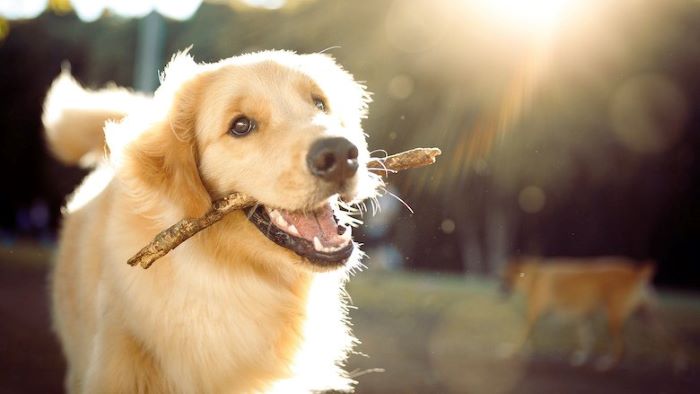
Key Takeaways
- Chewing on sticks is not safe for dogs. It can lead to injuries, digestive problems, and exposure to harmful substances on coated sticks.
- Dogs chew on sticks due to curiosity, boredom, teething, and their instinct to explore and chew on objects.
- Be attentive for signs such as vomiting, difficulty breathing, and changes in behaviour, as they may indicate potential issues from stick eating.
- Immediate veterinary attention is necessary for the dog’s safety.
- Train your dog with commands to leave or drop sticks from their mouth.
- Provide soft toys to your dogs to reduce stick eating.
Why Do Dogs Eat Sticks?
You may wonder why your dogs involve themselves in chewing sticks. There are a lot of options for your dog to eat, but why do they love to chew sticks?
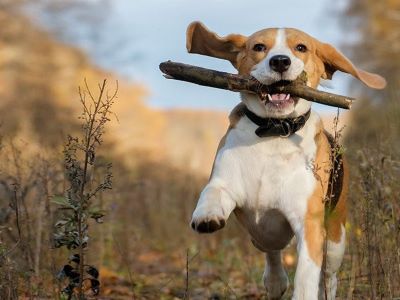
There can be a lot of reasons included in this activity such as :
- They may be responding to their instinct of chewing.
- The stick may contain some type of pleasant smell.
- Or your dog may be suffering from a condition called ‘pica’.
Some other reasons may differ from dog to dog such as:
Anemia
Anemia is a general medical term that occurs when the Red Blood Cells(RBC) or haemoglobin(Hb) decreases in the body. It can lead towards low stamina or energy in dogs and may lead towards weight loss in dogs.
Nutritional or Mineral Deficiency:
Some dog foods may contain artificial flavours which can lead towards nutritional deficiency in dogs.
So as a result, the dog may try to find sticks as a source of nutrition or minerals as the dog considers a stick as a bone.

Digestive Disorders:
Some dogs may have a digestive disorder that can cause digestive disorders and causes difficulty in absorbing nutrients from food.
It includes:
Dental or Oral Issues:
If your dog has gum disease or a cavity problem, your dog may start to chew sticks or leaves to comfort themselves.
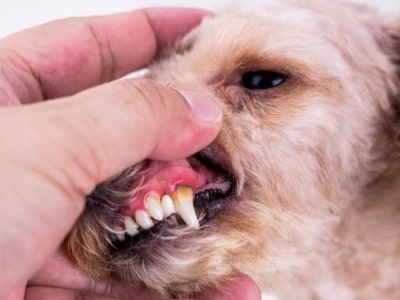
“Periodontal disease is the most common disease of dogs over the age of 3, but it is preventable! Introducing toothbrushing at a young age can make it a fun part of your dog’s daily routine” says Dr Mallory Kanwal on petMD
Hunger:
Dogs are generally considered those species who remain hungry all the time.

If your dog is not eating properly or fully, out of hunger your dog might start eating sticks while walking or playing.
Behavioural Problems
Many times due to behavioural problems, your dog may start eating non-food items such as sticks or leaves.
Behavioural problems can include:
- Boredom
- Anxiety or fear
- Looking for attention
- Habit
Teething:
Teething[1] generally occurs in puppies. By eating a stick a puppy can feel comfort.
This problem can be overcome by offering Soft toys to your puppies.

Is It Safe for a Dog to Chew on Sticks?
It is truly common to see your dog eating a stick. But is it safe?
Well according to many Vets, chewing sticks for a dog is not safe [2] They do not recommend this to the owner of the dog.
While eating a stick, the risk of breaking the stick and injuring the dog’s mouth increases. Also, there are chances of choking in case if the stick gets broken in the dog’s mouth.
Another reason for avoiding eating sticks is due to the poisonous nature of some sticks or the growth of fungus or mould on some of the dead sticks.
Stick-chewing might seem harmless, but it poses potential risks to your dog’s health. The dangers include:
- Injuries:
Splinters and sharp edges on sticks can cause injuries to your dog’s mouth, throat, or digestive tract.
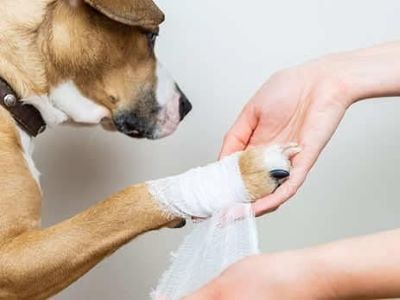
- Toxic Coatings on sticks:
Some sticks may be coated with harmful substances like pesticides or chemicals, posing additional threats to your dog’s well-being.

WHAT HAPPENS IF A DOG EATS A STICK?
In case your dog has swallowed the stick, then firstly the owner needs to ensure whether the stick is poisonous or not.
Sadly the stick won’t be digested by your dog. So, it can cause certain problems like choking, cutting or bleeding in the mouth or constipation in your dog.
In the worst case, the sharp edge of the stick may pierce the gut of the dog which can become a serious issue.
Risk & Consequences for Dog Eating a Stick:
In case you are wondering about the risks and consequences associated with your dog eating a stick. This section will help you to find the answer to that question.
It involves:
Potential Threats:
- Mouth injuries
Dogs will often catch sticks in their mouths while they are running towards you. Sometimes this can lead towards serious tears under the tongue, under the palate or in the throat or it can also give a deeper cut to your dog.
- Choking Problems:
Sticks can not only cause cuts in the mouth but it can also create choking problems. If it is broken into pieces, it can lead towards choking in the dog by getting stuck in the mouth.
- Digestive problems if large pieces are swallowed:
Swallowing a large piece of a stick can lead towards uncomfortable constipation in your dog.
Warning Signs:
The pet owner should not miss any warning signs in case your dog loves to eat or chew sticks. Monitoring your pet for the following signals can be helpful:
- Vomiting:
Vomiting in dogs is caused due to several reasons but if you see your dog constantly vomiting or if the vomit contains blood or unusual substance, then it is very much necessary to book an appointment with your vet.
Vomiting can be a sign of digestive issues or blockages caused by swallowed stick fragments.
2. Difficulty in Breathing:
In case your dog has swallowed the stick, then it may lead towards your dog having difficulty in breathing.
If your dog faces difficulty in breathing or coughing after eating a stick, then it is necessary to appoint a vet.
3. Changes in Behavior:
Dogs often communicate from their behaviour. So if you notice any change in their behaviour like discomfort or distress or increased aggression.
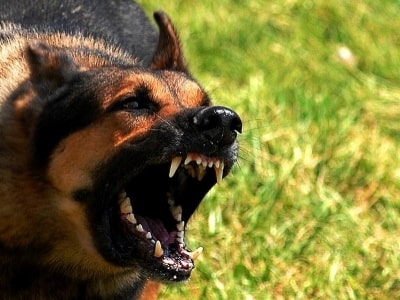
Then it is advised and safe to consult your vet.
Understanding and responding to these warning signs is crucial in ensuring the well-being of your furry companion.
Tip: Early intervention can help to prevent serious issues in your Dogs Health
HOW TO STOP YOUR DOG EATING STICKS?
Addressing stick-chewing behaviour in dogs involves a combination of training and providing suitable alternatives like:
Train Your Dog
Dogs can easily learn and understand commands from their owners. So, try to teach them the difference between eatable and non-eatable items.

Try to teach them with the command of “Leave It” or “Drop It” and provide them with their favourite treats if they obey your commands.
Provide Alternative Chew Toys:
Offering a variety of chew toys according to your dog’s preference can be a good option Dogs may have a preference for certain materials and textures.
Engage your dogs by giving them their preferred toy. Some dogs may like soft toys to play with.
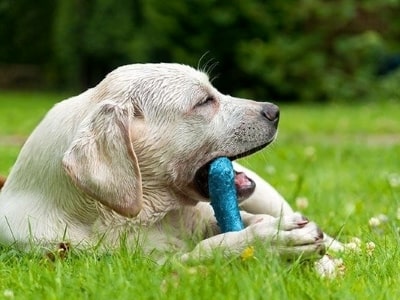
FAQs
Why do dogs chew on sticks?
Dogs chew on sticks for various reasons, including boredom, teething discomfort, an instinct to chew, and exploration of their environment.
Is it safe for dogs to eat sticks?
No, it’s not safe for dogs to eat sticks. Chewing on sticks can lead to injuries, such as mouth or throat damage, and ingestion of splinters can cause digestive problems. Some sticks may also be coated with harmful substances.
What are the risks of dogs eating sticks?
Risks include mouth injuries, choking hazards, digestive issues, and potential exposure to toxins from coated sticks. Ingested stick fragments may lead to blockages in the digestive tract.
How can I tell if my dog has eaten a stick?
Signs include vomiting, difficulty breathing, changes in behaviour, lethargy, and refusal to eat. If you observe these symptoms, consult with your veterinarian immediately.
It’s a Wrap
So, If you are asking “Can a dog eat a stick?” The simple answer to that is, No it is not advisable to eat stick for your dog. Because it can lead to different problems like choking, cutting the mouth or discomfort.
In case your dog has eaten a stick, Then don’t panic try to consult your vet and provide essential treatment to your dog.
Reference:
- Davdc, M. K. D. (2023, October 16). Everything you need to know about puppy teething. petMD
- Flaim, D. (2023, November 9). Sticks and Stones: Can they hurt dogs? American Kennel Club.



